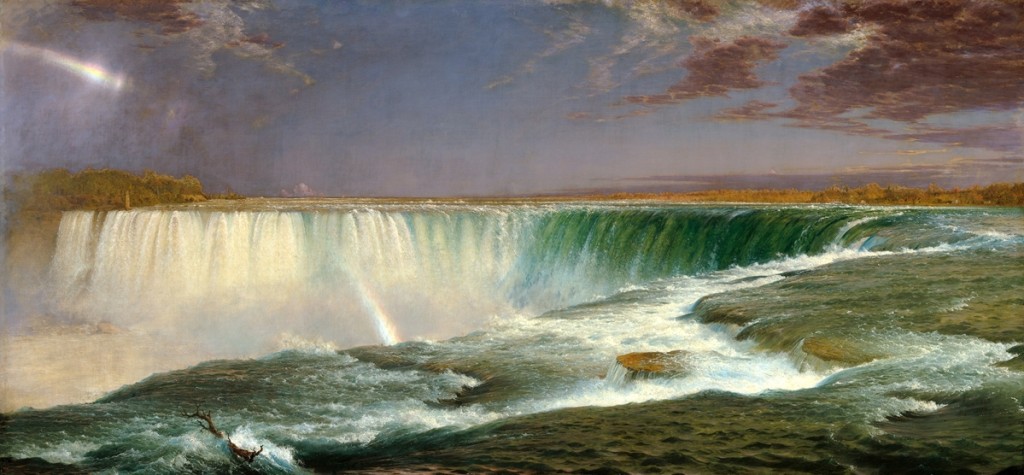
Skeleton of the Mastodon, excavated 1801-2 by Charles Willson Peale. Bone, wood and papier mâché, approximately 118 by 177 by 65 inches. Hessisches Landesmuseum, Darmstadt, Germany. Installation view of Alexander von Humboldt and the United States: Art, Nature, and Culture, courtesy of the Smithsonian American Art Museum, photo by Libby Weiler.
By Jessica Skwire Routhier
Ed note: due to the Coronavirus outbreak, the Smithsonian American Art Museum has closed and this exhibition will open at a future date, as yet to be determined.
WASHINGTON DC – Science is an overriding concern of American life today. An individual’s attitude toward, for instance, climate change, or vaccines, or gender identity is generally perceived to reflect the degree to which that person does or does not accept the truths of science. Thanks to the infamous Scopes trial of 1925, in which opposing views of human evolution were hashed out on a national stage, the last century has been dominated by a popular understanding of the works of Charles Darwin (1809-1882). Darwin’s theory of evolution emerged victorious from the Scopes trial, and with it his attendant ideas about the “survival of the fittest” – all life forms being in competition with each other for resources – and a general philosophy of natural progress: that over time, species’ adaptations would allow them to maximize their use of these resources.
But just like the giraffe’s long neck and the elephant’s prehensile trunk, Darwin did not emerge, instantaneously, out of nothing. His ideas evolved, as it were, from an Enlightenment-era approach to science that was rooted in the observation of the natural world, on every continent of the earth, and that set the stage for Darwin’s revolutionary ideas about the relationship between organisms and their environment. More than any other individual, the naturalist Alexander von Humboldt (1769-1859) drove and popularized that earlier movement; in his day his name was every bit as well known as Darwin’s, and his ideas were, if anything, even more celebrated. Although Humboldt was German and lived his life, when not exploring, in Paris and Berlin, he had a special relationship with the United States, dating from his first and only sojourn there in 1804. “Alexander von Humboldt and the United States: Art, Nature, and Culture,” at the Smithsonian American Art Museum (SAAM), originally scheduled to open March 20 through August 16, tells the story of that visit and its aftermath through the work of the American artists who were influenced by his expansive, exhaustive and reverential study of nature.
Alexander von Humboldt was already famous for his South American expeditions and his writings about them when he stepped onto the dock at Philadelphia in 1804 and was greeted by artist Charles Willson Peale. Peale was famous, too, having three years earlier excavated the skeleton of a prehistoric mastodon in upstate New York, reassembled it (partially by hand-carving missing sections of bone), and placed it in his museum in the City of Brotherly Love. “They had dinner underneath his mastodon after touring DC,” says exhibition curator Eleanor Jones Harvey, senior curator at SAAM; it seems wildly appropriate, then, that this very same mastodon skeleton introduces museumgoers to the present exhibition, just as it introduced Humboldt to the United States. Brought with some effort and much ballyhoo from the Hessisches Landesmuseum in Darmstadt, Germany, where it has been since 1855, the mastodon occupies the center of the special exhibition galleries, literally providing a framework through which to view the artworks that encircle it. “Because the mastodon is a skeleton and you can see through it,” says Harvey, “you can see ahead to where you are going and back to where you have been.” Indeed.
But why such a prominent place in an exhibition that is otherwise of paintings, drawings, prints, and sculpture? What, really, does the mastodon have to do with art? A lot, it turns out. Peale, 63 at the time of his meeting with Humboldt, had been a celebrated portraitist in his prime, but was “functionally retired” by 1804, according to Harvey, and focusing primarily on his museum project. But somehow, Harvey says, that encounter with the great German naturalist underneath the massive bones he had salvaged from the earth “makes Peale realize that he still has things he wants to say.” Within two years, Peale painted “The Exhumation of the Mastodon,” a massive, genre-defying work of art that spans portraiture, landscape, history painting and scientific illustration. He went on to channel his gift for portraiture and passion for science into a series of other important works, including two late famed self-portraits done in his 80s: one in which he draws a curtain back to reveal the interior of his museum, and another in which he presents a massive mastodon bone to the viewer. All of these, plus the portrait Peale did of Humboldt during their visit, are part of SAAM’s show.
The enormity of the mastodon was part of what made it so remarkable. It was also remarkable that this largest of all land mammals was, apparently, unique to North America; in this way, it was part of a key group of natural wonders that helped to shape the identity of the young United States. “Most countries pin their identities on things that they make,” says Harvey – cathedrals, aqueducts, palaces, temples – “we decided to pin our cultural identity on what was already here, on features in the landscape. That’s a pretty radical departure.” Correspondingly, the mastodon is accompanied by representations of other mammoth-sized natural wonders, including paintings of Niagara Falls and Virginia’s Natural Bridge by the crown prince of the Hudson River School, Frederic Edwin Church.
“Church is functionally raised on Humboldt,” says Harvey, observing that Humboldt was well established in school curricula by the second quarter of the Nineteenth Century. By the time Church came of age, Humboldt’s magnum opus, Cosmos, had begun to be published. The second volume, which came out in 1847 when Church was 21, includes an extensive section, about one-third of the total volume, in which Humboldt advises landscape painters on how to study the natural world and represent it in their artwork. “For Church, the advice that he got and that he took to heart was that as an artist you have to also be enough of a scientist to understand what you’re looking at,” says Harvey. “His advice to the scientist is never lose the sense of wonder; to the artist, it’s don’t forget the science as well as the aesthetics.”
Such a philosophy bears up well today – especially now that representation is back in vogue and there is a renewed artistic interest in landscape and ecological art. (Harvey says she would have liked to do an ancillary show of contemporary art.) It also dovetails well with Humboldt’s overall view of the interconnectedness of all things; in Cosmos and his other writings, Humboldt espoused the idea of the “unity of nature.” In his preface for Harvey’s outstanding catalogue, SAAM’s chair of paleobiology, Hans-Dieter Sues, writes, “Humboldt saw humans as part of nature, not outside it, and warned that they were capable of destroying it. He viewed the atmosphere, land and sea, and all life-including humans-as parts of a harmonious, interconnected, and interdependent whole.” This, Sues observes, was a “radical idea” for the time, and, again, it helped establish a basis for Darwin’s observations about how living things adapt to their environments. But whereas Darwin’s theories, in much of Twentieth-Century thought both in and outside of the sciences, have fostered many spinoff theories on how to adapt or die, to win the great contest that is life, Humboldt’s focus on interdependence, rather than competition – along with his prescient observations about climate change and environmental degradation – give him unique relevance to our present moment.
Humboldt was also forward-looking in other respects, reflected here in groupings of objects that are related to his support of the American abolitionist movement, his interactions with America’s Indigenous peoples, and his lasting influence in Latin America, where he has long been seen as a thought leader for several countries’ revolutionary movements. “There’s no question that when [Simón] Bolivar met Humboldt in 1804/1805 in Paris, he was deeply influenced by Humboldt’s belief in the natural equality of the races,” Harvey says. “Humboldt hates colonialism, hates monarchy; he and Napoleon are constantly at odds…and Bolivar wants to free his native Venezuela and throw off Spanish oppression.” In Mexico, she notes, Humboldt is seen as “the father of modern archeology,” having encouraged interest in and respect for preserving pre-Columbian architecture and artifacts. And Humboldt’s early expeditions in South America influenced artists like Church to follow in his footsteps, helping to make the profiles of peaks like Ecuador’s Cotopaxi and Chimborazo as familiar worldwide as those of the Alps.
In the Indigenous peoples of the United States, with whom Humboldt interacted on both sides of the Atlantic, Humboldt saw a vibrant, non-European cultural tradition equally worthy of esteem. He took great interest in the artist and ethnographer George Catlin’s traveling troupe of Iowa (Báxoje) when they toured Paris, and he became a lifelong friend of Catlin’s. Today Catlin’s ethnographic portraits – and by extension, his friendship with Humboldt – can be somewhat difficult to parse. Catlin was in it to become famous and make money, at least in part, and he was also interested in his performers and portrait subjects primarily as representatives of a “vanishing race,” so his work can feel exoticizing and even exploitative. He was criticized even at the time by more academically trained artist-ethnographers, including Karl Bodmer, whose 1830s trip to the United States to study Indigenous populations was directly inspired by Humboldt and resulted in a series of popular publications and engravings, also represented in the show.

“Niagara” by Frederic Edwin Church, 1857. Oil on canvas, 40 by 90½ inches. National Gallery of Art, Corcoran Collection, museum purchase, Gallery Fund.
Revolutions in Humboldt’s native Germany beginning in 1848 “solidified him as a political radical,” Harvey says, dedicated to the idea of “equality of the races and support for an American-style democracy.” But he was well aware of the failures of the American experiment, specifically the proliferation of chattel slavery, which he vigorously opposed throughout his life. Early on, Humboldt showed a reluctance to engage directly in political discourse about slavery, though he was unguarded in his personal correspondence. Later, however, after decades of describing himself as “half an American,” he vocally endorsed the 1856 Presidential campaign of the abolitionist John C. Fremont against Millard Fillmore. A campaign ambrotype of Fremont, as well as John Quincy Adams Ward’s celebrated sculpture “The Freedman,” commemorate this crucial aspect of Humboldt’s political and philosophical life.
Unfortunately, Humboldt did not live to see the emancipation of America’s enslaved citizens. He did, however, live just long enough to witness an important historic moment that he thought might serve to bring the world together – and in which he played a not-insignificant role. The first communications across the transatlantic cable occurred on August 16, 1858, a satisfying but by no means assured advancement in the telegraph technology invented by artist and Humboldt devotee Samuel F.B. Morse. While Humboldt could and did not claim a primary role in that invention, his lifelong research into the earth’s electromagnetic fields was important foundational work. Beyond that, he was a “networker and a facilitator,” Harvey says, part of the circle of educated, ambitious, creative people imagining the possibilities of instantaneous global communication and figuring out how to make it possible. Two paintings, Daniel Huntington’s group portrait “The Atlantic Cable Projectors,” and Church’s riveting “Aurora Borealis,” together illustrate this remarkable scientist’s interconnected allegiances to the observation, study and majesty of the natural world.
The Smithsonian American Art Museum is at 8th and F Streets NW. For information: www.americanart.si.edu or 202-633-7970.



















